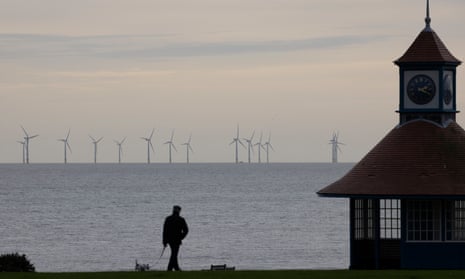Great Britain’s windfarms set a new clean energy record on Monday after the blowy bank holiday weather helped onshore and offshore wind turbines make up almost half of the electricity system.
The blustery bank holiday produced a new wind power record as turbines generated just over 17.6GW of electricity for the first time in the middle of Monday afternoon, enough to run more than 3.5m kettles.
Windfarms generated 48.5% of the electricity grid in England, Scotland and Wales, which was more than the contribution made by gas plants, nuclear reactors and biomass burners combined. Gas plants powered 21.7% of the electricity grid yesterday afternoon, while nuclear reactors generated 12% and biomass power units contributed 6.1%.
However, the washout weather meant less clean electricity from solar farms, which made up 2.3% of the electricity mix.
Wind turbines played a slightly larger role in keeping the lights on between Christmas and New Year last year when wind power made up more than 50.6% of electricity, but generated fewer gigawatts, because overall demand for power was lower.
The new high for wind output narrowly overtook a previous record, set in February, of 17.5GW when Storm Darcey propelled wind power to 56% of Great Britain’s electricity. Before this, wind turbines reached a peak on Boxing Day, when Storm Bella helped them to generate just over half of Great Britain’s electricity.
The highest percentage of wind power in the power grid was recorded last summer, when demand for electricity is typically lower, at 59.9% of the power mix. National Grid’s electricity system operator (ESO) recorded a string of green electricity records in 2020, in part because the Covid pandemic helped to lower demand for electricity, which edged out fossil fuels.
The ESO recorded the electricity system’s greenest-ever year after the average carbon intensity for 2020 fell to 181g of CO₂ per kilowatt hour of electricity generated following the longest coal-free run since the Great Britain began generating electricity from coal in the Industrial Revolution. England, Wales and Scotland went without coal power for 68 days between 10 April and 16 June.
